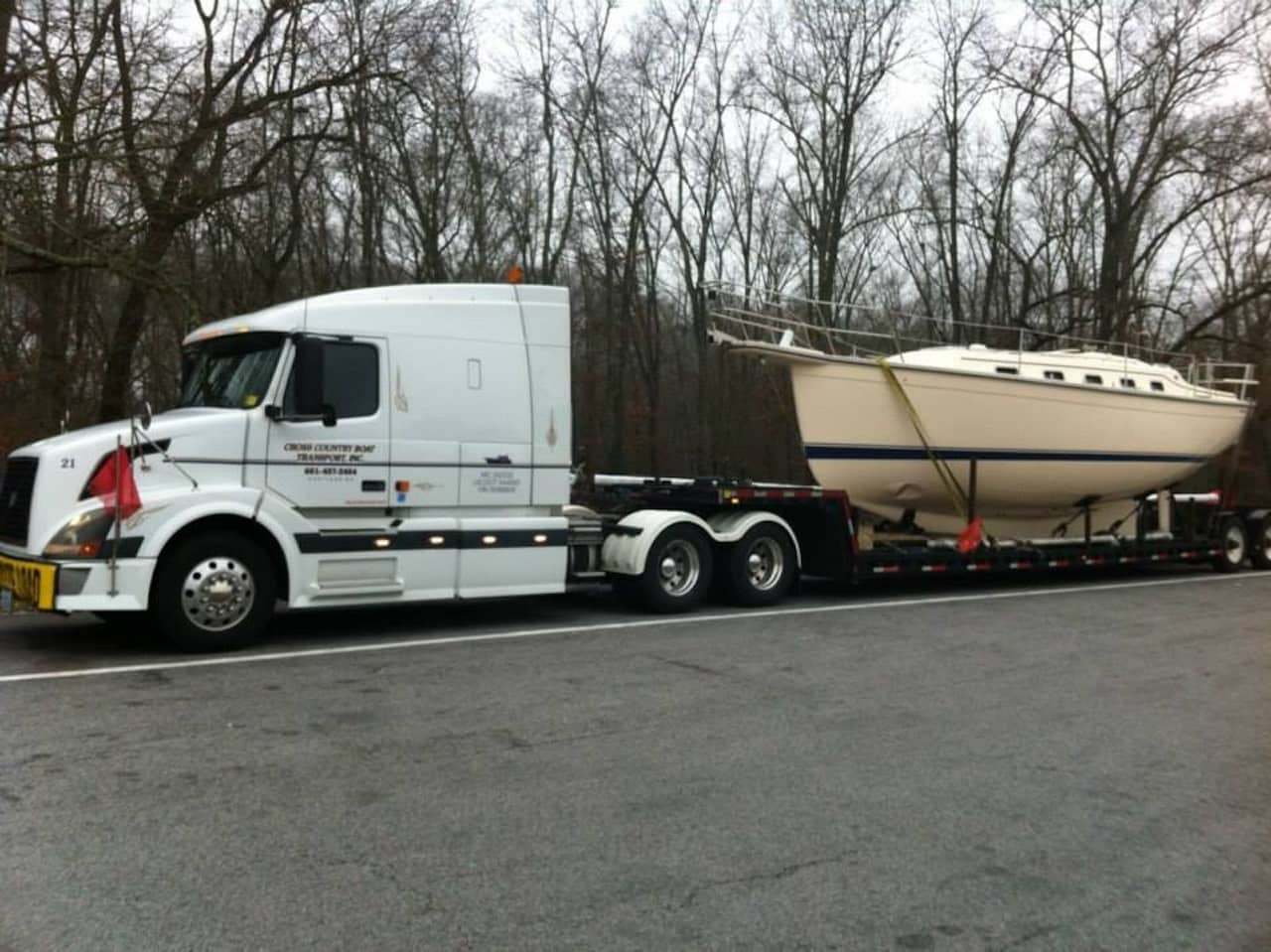Shipping a boat isn’t quite as daunting as it might seem, and it’s common practice in the Unites States and across the world to see even large vessels making their way to a distant port by land or by water. There are many reasons you might need your boat moved large distances, from purchasing a boat that isn’t close by, to moving to a new region, to choosing to explore far-away waters. There are several ways to ship a boat for you to consider, and the right one will depend on the size and type of the boat, the distances involved, and of course the budget.

A sailboat being transported overland by a professional boat haulage company. Cross Country Boat Transport photo.
Reasons for Shipping a Boat
When talking about shipping a boat, we could be referring to a 50-mile move from a boat show to your home or local marina, or across oceans from one continent to another. Boats are shipped for many reasons, including;
- Purchase: You may have found a fantastic deal at a boat show that isn’t near your home, or bought directly from the manufacturer whose shipyard isn’t local. Be sure to check out our comprehensive guide on How to Buy a Boat first.
- Relocation: If you’re moving to a new home, whether that’s inter-state or half-way around the world, you’ll probably want to take your beloved boat with you and, as we’ll see below, there are several ways that can happen.
- Distance: If the distances involved are such that your boat wouldn’t be able to safely make the crossing, then it’s time to consider a boat transportation company.
- Lack of skill or time: If your sailing or navigation skills aren’t at a level that you could safely transport a boat long-distance by yourself—or you don’t have the time to do so—then there are other methods you can use.
Shipping a Boat by Trailer
Putting your boat on a trailer and towing it using your own vehicle is undoubtedly the most straightforward and cost-effective method of shipping a boat from A to B. It’s a practice that happens in its thousands every weekend across the United States, as boat owners load up their boats and families and head off for a day on the water. Trailering allows for cheaper storage options (see our article on Storing Your Boat) as well as opening up your options of cruising or fishing grounds.
When it comes to shipping a boat longer distances, the only additional factors you need to take into account are the extra fuel costs. But there are factors to consider before deciding whether trailering your boat significant distances is the right option;
- The size of the boat: Each country and, in the U.S. each state, has its own legal limits on what can be towed, so be sure to check locally (and where you’re headed) before deciding on this option. In general, in the United States, the maximum trailer length varies from 30 to 60 feet (most commonly around 45 to 48 feet), and they will also factor in a combined vehicle and trailer length that tends to be between 50 and 85 feet (commonly around 65 feet). Width limits also vary but are usually 8' 6," while the minimum trailer weight requiring separate trailer brakes is between 1500 lbs. and 4000 lbs.
- The towing vehicle: The vehicle that you use to tow your boat needs to be powerful enough to do so with ease, as well as fulfilling the legal requirements of your state or country to stay within the Gross Combined Vehicle Weight (GCVW) i.e. the total weight of the towing vehicle, the trailer, the boat, and equipment and passengers.
- The driver’s experience: If you don’t feel comfortable towing your boat or haven’t had any experience doing so before, then it’s best to opt for a different way to get your boat where you need it. Towing presents additional challenges to normal driving, and even things like potholes, sharp curves, or diversions off the main routes can make towing a challenge. Ensure the trailer is fit for purpose, the boat is positioned correctly, and the weight is distributed evenly before setting off. Be sure also to check all the tires on both the trailer and towing vehicle, and to have the brakes professionally checked.

Trailering a boat yourself is the most cost-effective and straightforward option.
Shipping a Boat Over Land with a Boat Hauler
Multi-boat trailers or flat-bed trucks are commonly used by professional boat-hauling companies to transport boats overland on behalf of their owners (as well as the option of having your boat trailered professionally). While there is the added cost of the shipping compared to trailering it yourself, hauling companies do all the work for you of loading, towing, and unloading the boat, and they’ll be insured in case anything goes wrong along the way.
The size of boat that can be shipped overland using a haulage company is larger than can be trailered—commonly around 50 to 60 feet as long as they are no wider than 12’0” and no taller than 13’6” after lowering of masts and bridges.

A large boat being transported overland by a professional boat hauling company. Cross Country Boat Transport photo.
Shipping a Boat on a Yacht Transport Ship
If you’re looking to move a larger boat long distance, perhaps across an ocean, or coast to coast, then yacht transport ships can accommodate even the largest of yachts. Known as OTIs (Ocean Transport Intermediaries) or NVOCCs (Non-Vessel Operating Common Carriers), they are unique vessels that allow boats and yachts to either be floated in or lifted on board. The most common size of vessel transported is anywhere from 35 to 150 feet, but vessels can be much, much larger.
There are many positives to using this kind of service, such as the fact that you’ll add no engine hours, or wear and tear to your vessel, as well as it being fully insured. Specialist companies will help you arrange all the logistics for your boat’s journey, taking the stress out of it for you. The downsides to this option are the often high costs, as well as the need for the boat to get to the embarkation point.

If you’re looking to move a larger boat long distance, then yacht transport ships can accommodate even the largest of yachts. Peters & May photo.
Shipping a Boat on Keel
To ship a boat on its own keel or its own bottom means to sail it under its own steam, by yourself or using professional delivery captains. When a boat needs transporting long-range across water, it’s an obvious option to sail or cruise it there (See "Delivering Your Own Boat: Lessons Learned."). Of course, many factors need to be taken into account before deciding on that course of action;
- Boat size and type: You won’t be cruising a 20-foot center console across the Atlantic, so it goes without saying that any boat must be well up to the task you’re asking of it. Ensure the boat is well-maintained too and has all relevant safety and navigation equipment in place.
- Captain skill: If you’re planning on sailing the boat, be honest with yourself about your skill level and consider taking along a more experienced skipper for the journey.
- Time of the year: If time is of the essence in getting your boat to where it needs to go, make sure you don’t push the limits of the season or weather when making the decision to go it alone.
This article was published in September 2020 and updated in March 2024.




